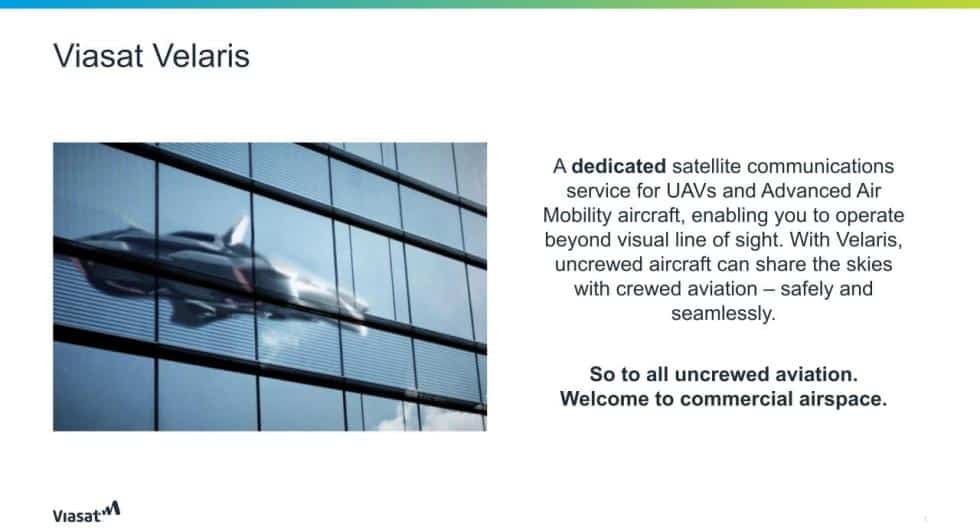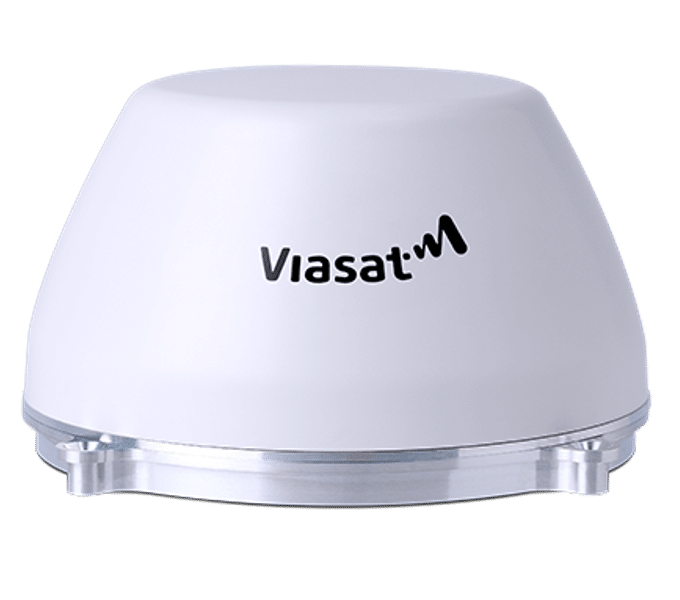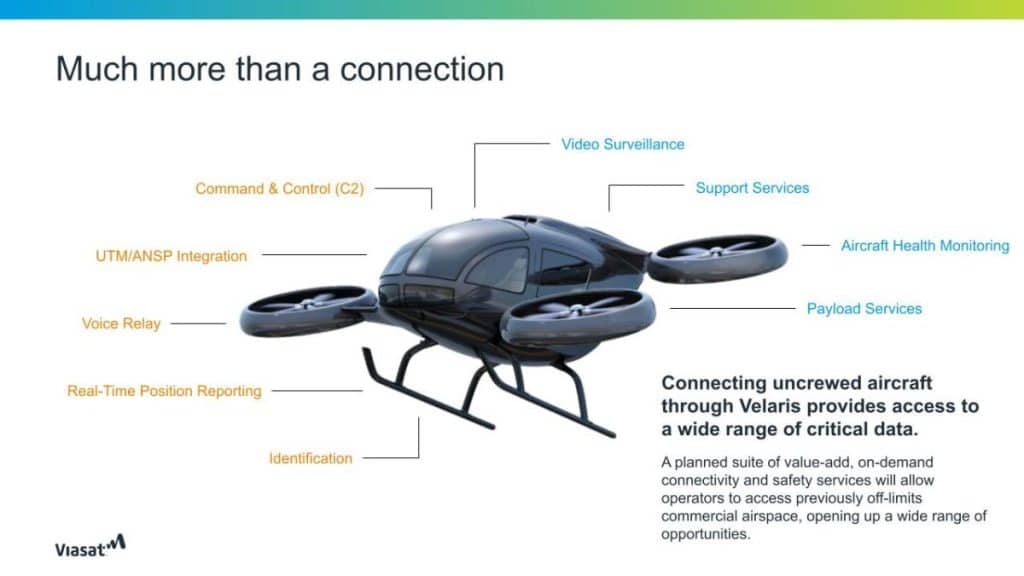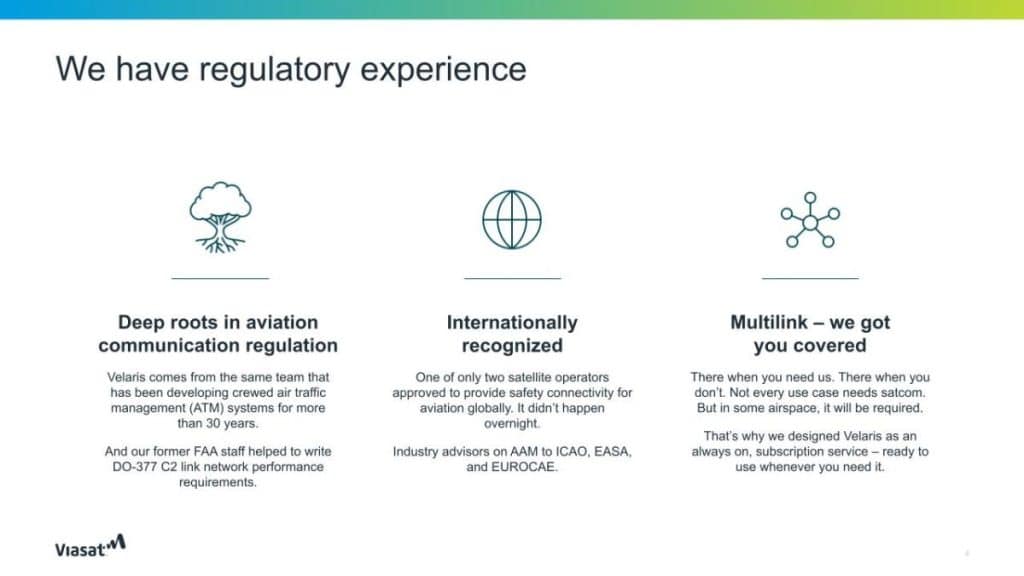Viasat: Connecting Safety and Standards for Advanced Air Mobility
April 24, 2025 | Dawn Zoldi

As advanced air mobility (AAM) technologies like drones and eVTOLs (electric vertical takeoff and landing aircraft) take flight, the aviation industry faces a critical challenge: ensuring safety in an increasingly complex airspace. Viasat, a global leader in satellite communications, has stepped up to meet this challenge. Leveraging over three decades of expertise, the company aims to address critical gaps in aviation safety and standards through engagement and its Velaris solution that enables safe and reliable command-and-control (C2) links for AAM vehicles. Lisa Bee, Viasat’s Director of Air Traffic Services, recently shared her insights on the importance of aviation safety communications and shed light on the company’s pivotal role in shaping the future of AAM during a recent Dawn of Autonomy podcast interview.
Lisa Bee: A Lifelong Advocate for Aviation Safety
Lisa Bee brings a wealth of experience to her role at Viasat. A retired air traffic controller with over 20 years at the Federal Aviation Administration (FAA), Bee has spent her career immersed in air traffic management (ATM), testing and regulatory procedures. For the past nine years, she has worked with Inmarsat—now Viasat following their 2023 acquisition—where she has focused on satellite communications (satcom) for aviation safety.
“We’ve been engaging with organizations like ICAO (International Civil Aviation Organization) for decades,” Bee explained. “We’ve been working on global safety standards and rules for both the aviation and maritime sectors. Now we’re bringing that same expertise into the uncrewed aircraft and advanced air mobility sector.”
Bee’s extensive involvement in regulatory bodies, such as RTCA and EUROCAE, underscores her commitment to building a safer airspace for emerging technologies. Her leadership ensures that Viasat remains a key partner in developing standards for integrating uncrewed aircraft safely into shared airspace worldwide.
The Origins of Viasat’s Aviation Expertise
Viasat’s journey into aviation safety began long before its 2023 acquisition of Inmarsat. Both companies were pioneers in geosynchronous satellite constellations, providing reliable connectivity for commercial and military applications. Inmarsat alone had over 30 years of experience in aviation safety communications.
This acquisition created a powerhouse in satellite-based aviation safety services. Together, both companies bring decades of excellence in maritime operations, commercial air transport and defense connectivity solutions, all transferable to the AAM sector.
Why Geosynchronous Satellites Matter
Geosynchronous satellites are positioned approximately 22,000 miles above Earth’s surface. This allows them to provide consistent coverage across vast areas.
“Our GEO satellites offer continuity and high availability,” Bee explained. “We use L-band spectrum for our aviation safety services because it’s highly reliable—99.9% availability—and resilient to issues like rain fade.”
This reliability is crucial for beyond visual line of sight (BVLOS) operations, essential to scale drone deliveries, pipeline inspections and eVTOL passenger flights. Unlike terrestrial systems such as LTE or 5G, GEO satellites are not obstructed by terrain or infrastructure. This makes them ideal for both urban and rural environments.
The challenges facing AAM operators vary significantly between urban and rural settings. In cities, dense infrastructure can disrupt terrestrial communication links like LTE or 5G. Meanwhile, rural areas often lack sufficient cellular coverage altogether.
This flexibility makes Viasat an indispensable partner to provide satcom-enabled aviation safety C2 for industries ranging from energy companies conducting pipeline inspections to logistics firms managing offshore drone deliveries.
What Are Aviation Safety Communications?
Aviation safety communications are specialized systems that ensure the secure and reliable exchange of critical information between aircraft and ground systems. These links are essential for maintaining operational control, particularly in BVLOS operations where traditional line-of-sight communication such as terrestrial networks fall short.
Bee explained that these communications encompass a range of services: “For traditional aircraft, safety communications include voice communication between pilots and controllers, data link communications for system updates and surveillance technologies used in remote airspace.”
For AAM operations, these functions are adapted to accommodate the unique requirements of uncrewed aircraft, where pilots are based on the ground and rely entirely on robust C2 links to monitor and manage flights.
Today, Viasat is one of only two companies globally certified by the FAA to provide specialized aviation safety communication links. This designation highlights its unparalleled reliability, safety and expertise.
Why Safety Communications Matter for BVLOS Operations
By opening up opportunities for applications like drone deliveries, infrastructure inspections, and passenger-carrying eVTOLs, the ability to operate BVLOS changes the game for the AAM industry. However, BVLOS operations also introduce new risks that require robust safety measures.
“Aviation satellite communications are critical because they ensure continuous connectivity between the vehicle and its operator,” Bee elaborated. “This is especially important when you’re managing flights remotely or in areas with limited terrestrial infrastructure.”
Viasat’s geosynchronous satellite network plays a pivotal role in mitigating these risks by providing reliable connectivity regardless of location or altitude. As Bee put it: “If we can provide services over the Indian Ocean, we can certainly do so in remote areas like Wyoming.”
Velaris: The Future of AAM Connectivity
Viasat’s purpose-built Velaris, a dedicated satellite communication service, specifically for UAVs and AAM platforms. Built on the same L-band network used by commercial airlines, Velaris provides secure command-and-control (C2) links essential to BVLOS operations.

“Velaris is supported by the exact same high-availability satcom network we use for thousands of commercial air transport aircraft,” Bee explained. “It’s tailored specifically for the civil UAS and AAM industry.” Key features of Velaris include:
High Availability Through L-Band Spectrum
Velaris operates on Viasat’s L-band satellite network, specifically protected for safety-critical applications. “L-band is designed for high reliability,” Bee said. “You don’t want dropped signals or interruptions when managing an aircraft remotely.”
Modular Open Systems Architecture
The modular design of Velaris allows it to integrate with various technologies, including detect-and-avoid systems, video compression tools, and GPS navigation. “Velaris isn’t just a communication link—it’s part of a larger ecosystem that supports safe and efficient operations,” Bee noted. This flexibility enables operators to tailor solutions based on specific mission requirements.

Multi-Link Capability for Redundancy
Velaris supports a multi-link configuration that combines satellite connectivity with terrestrial networks like LTE or C-band radios. This ensures redundancy and seamless performance across different scenarios. “No single link can provide the level of availability needed,” Bee emphasized. “By pairing satcom with another type of link, you create a system that’s both robust and adaptable.”
Global Coverage Without Line-of-Sight Limitation
Powered by multiple GEO satellites, Velaris offers uninterrupted connectivity anywhere in the world. This makes Velaris ideal for BVLOS operations in diverse environments.
The Path Ahead: Standards and Industry Engagement
Viasat works closely with stakeholders across the AAM ecosystem to advance safety standards and operational capabilities. From vehicle manufacturers to system integrators and regulatory bodies like ICAO and RTCA, these collaborations ensure that Viasat’s solutions meet both current needs and future challenges.
“We’re actively participating in groups like RTCA SC-228 and ICAO’s remotely piloted aircraft systems panel,” Bee explained. “These organizations rely on our expertise to develop standards that reflect state-of-the-art technology while addressing operational needs.”
Viasat also partners with industry leaders to test integrated solutions in real-world scenarios. These ongoing trials will generate valuable data to inform both FAA and international regulatory frameworks and help refine concepts of operation (CONOPS).
Bee stressed the need for other private industry players to also collaborate with each other and regulatory bodies to ensure safe integration into shared airspace – especially if the federal government continues to pull back from global leadership in these bodies.

“Safety standards take time—it’s a slow process—but they’re essential,” she said. “The only way these standards will reflect real-world needs is through active participation from industry stakeholders.”
She offered practical advice for companies looking to engage with standards bodies:
- Join Trade Organizations: “Membership in organizations like AUVSI provides access to working groups where you can share your expertise.”
- Provide Data: “Standards bodies need real operational data to develop effective rules. Participate in trials and share your findings.”
- Stay Informed: “Follow ICAO workshops or events—they’re open forums where you can have your voice heard.”
- Collaborate: “Engage with partners across the ecosystem—vehicle manufacturers, UTM providers—to align on operational needs.”
By taking these steps, companies can help shape a safer future for advanced air mobility while ensuring their technologies align with global standards.
Connecting the Industry For a Safer Future
Looking ahead to 2025, Viasat plans to expand its testing programs while continuing its advocacy for harmonized global standards. The company will also showcase its solutions at key industry events like XPONENTIAL 2025.
With its rich history in aviation safety communications and cutting-edge solutions like Velaris, Viasat remains uniquely positioned to connect the AAM industry for a safer future. By combining technical expertise with active engagement in regulatory frameworks, the company appears to not just be supporting this new era of aviation, but defining it.
As Bee aptly put it: “This industry has so much potential—but unlocking it requires reliable connectivity, robust safety standards and collaboration across all stakeholders.”
- Podcast


